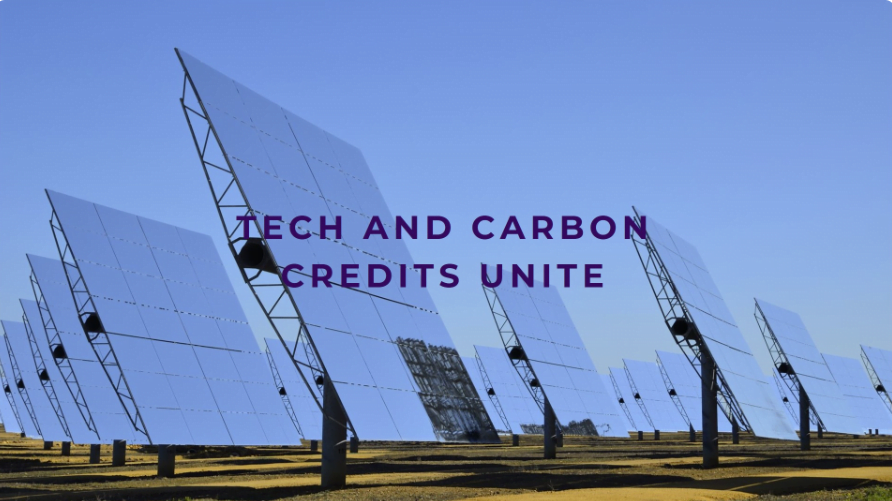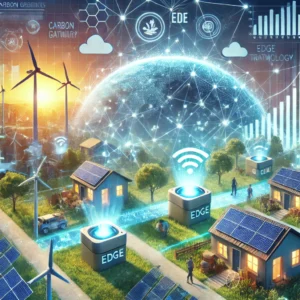
Edge Tech Meets Carbon Credits: A Game-Changing Role for Sustainable Impact Businesses
In today’s rapidly evolving technological landscape, edge computing is emerging as a crucial player in the world of sustainability. But perhaps one of the most overlooked opportunities for edge technology lies in its potential to revolutionize the carbon credit market. Small impact businesses—particularly those in developing regions like Africa—have traditionally struggled to participate in this market, often limited by financial constraints and a lack of infrastructure. However, with the advent of edge computing and innovative companies like ARED pioneering new infrastructure solutions, these businesses are now gaining the ability to thrive in the carbon credit market, offering them a pathway to financial sustainability beyond reliance on low-income communities.
This article will explore how edge technology is poised to reshape the carbon credit landscape and how businesses with a focus on sustainability can leverage this game-changing infrastructure to secure financial independence while making a positive environmental impact.
The Challenge for Small Impact Businesses
Many small businesses, especially those in rural or underserved areas, have a clear social and environmental mission, whether it’s reducing waste, using renewable energy, or promoting circular economy principles. These businesses, often referred to as impact businesses, strive to make a tangible positive difference in their communities. However, despite their noble missions, they frequently face one glaring challenge: financial sustainability.
Traditional revenue streams in these areas, where customer bases may consist of low-income communities, make it difficult to grow and expand. Without significant investment or a steady, diverse source of revenue, many of these businesses struggle to stay afloat. One promising solution to this problem is participation in the carbon credit market, which allows businesses to monetize their environmental impact by selling carbon credits.
Unfortunately, participating in the carbon credit market has historically been a complicated and expensive process. The costs associated with verifying and tracking carbon reduction projects, combined with the need for data collection and reporting, create significant barriers for small businesses. This is where edge technology comes in, providing a decentralized, real-time solution to track and verify carbon-reducing activities.
Understanding the Carbon Credit Market
The carbon credit market allows companies, organizations, and even individuals to earn credits by reducing their carbon emissions. These credits can then be sold to other companies that need to offset their emissions, providing an additional revenue stream. For example, if a small business in Africa installs solar panels to reduce its dependence on fossil fuels, it can earn carbon credits for the amount of carbon dioxide it offsets.
While large corporations with access to sophisticated technology and resources can easily participate in this market, small impact businesses often lack the tools and infrastructure to collect the necessary data to verify their activities. Enter edge computing—a solution that can enable these businesses to tap into the carbon credit market without needing extensive resources or costly data collection systems.
What is Edge Technology, and How Does It Help?
Edge computing refers to a decentralized processing model in which data is processed closer to the source rather than relying on centralized cloud servers. By processing data locally at the “edge” of the network, edge computing reduces latency and improves real-time data processing capabilities.
For small impact businesses operating in remote or underdeveloped areas, edge technology offers a way to process data locally, reducing the need for a constant internet connection or expensive cloud infrastructure. This is critical for tracking and verifying the environmental impact of their activities in real-time—whether it’s monitoring energy usage, emissions, or other carbon-reducing actions.
ARED’s Role: Pioneering Edge Infrastructure for Impact
One company that is at the forefront of this transformation is ARED, a Rwanda-based tech company known for its solar-powered kiosks and edge infrastructure. ARED’s edge gateway technology, which is powered by BalenaOS, is designed to provide local businesses with the tools they need to thrive in a decentralized, digital world.
ARED’s edge infrastructure plays a crucial role in helping small businesses participate in the carbon credit market by enabling real-time monitoring and data collection. Using ARED’s edge gateways, impact businesses can easily track their carbon-reducing activities, such as renewable energy usage or waste reduction, and convert that data into verifiable carbon credits.
For example, a small business that installs solar panels to power its operations can use ARED’s edge infrastructure to track how much energy is being generated and how much carbon dioxide is being offset. This data is collected and processed locally by the edge gateway, ensuring that it is accurate, secure, and readily available for reporting to carbon credit verification agencies.
By providing businesses with the tools they need to verify their carbon reductions, ARED’s edge infrastructure enables them to tap into a valuable new revenue stream—the carbon credit market—while reducing their dependence on traditional revenue sources from low-income communities.

The Financial Benefits for Small Businesses
For small impact businesses, the ability to participate in the carbon credit market offers a significant financial opportunity. By earning and selling carbon credits, these businesses can generate additional income without having to raise prices for low-income customers or rely on external funding sources.
The edge technology provided by ARED not only facilitates participation in the carbon credit market but also offers several additional financial benefits:
- Reduced Costs: Traditional carbon credit verification systems often require costly data collection and reporting tools. By processing data locally with edge technology, businesses can reduce the need for expensive third-party services, lowering their overall operating costs.
- New Revenue Streams: By selling carbon credits, businesses can earn money for the environmental impact they are already creating, allowing them to diversify their income sources.
- Increased Efficiency: Edge computing provides real-time data processing, enabling businesses to optimize their operations and reduce energy consumption. This not only lowers costs but also generates more carbon credits for sale.
- Scalability: As businesses grow and scale, edge technology can easily expand to accommodate new projects or locations, ensuring that companies can continue to participate in the carbon credit market as they grow.
A Path to Financial Sustainability
The introduction of edge technology into the carbon credit market offers a pathway for small impact businesses to achieve financial sustainability. By enabling real-time data collection, processing, and verification, edge computing simplifies the process of earning carbon credits, making it accessible to businesses that would otherwise be excluded from this valuable market.
Moreover, by reducing reliance on traditional revenue sources from low-income communities, these businesses can create more sustainable, long-term financial models that allow them to continue their work without compromising their mission.
The Broader Impact of Edge Technology
Beyond its financial benefits, the use of edge gateways like those provided by ARED has the potential to create a broader environmental impact. By making the carbon credit market more accessible to small businesses, edge technology incentivizes more companies to adopt carbon-reducing practices. As more businesses participate, the overall reduction in carbon emissions grows, contributing to global efforts to combat climate change.
Additionally, by supporting local businesses, edge infrastructure helps strengthen local economies and promote economic development in regions like Africa, where access to traditional infrastructure is often limited.
Conclusion: The Future of Impact and Sustainability
As the world increasingly shifts toward sustainability, the carbon credit market will play a vital role in helping businesses reduce their carbon footprint and generate additional revenue. However, for small impact businesses in developing regions, participating in this market has historically been a challenge due to financial constraints and a lack of infrastructure.
By leveraging edge technology, companies like ARED are helping to level the playing field, giving small businesses the tools they need to participate in the carbon credit market and achieve financial independence. As edge infrastructure continues to evolve, its role in the carbon credit market—and in sustainable impact businesses—will only grow, offering a promising future for both business owners and the planet.
In the world of sustainability, it’s clear that the future belongs to those who embrace both technology and innovation. With edge gateways and carbon credits leading the way, small businesses have the opportunity to become financially sound while making a lasting impact on their communities and the environment.


